PAC-10 CO-CHAMPIONS. HOORAY.
The very definition of
bittersweet. If Cal had taken care of business against Arizona, we'd be Pasadena-bound. We hope that lesson sinks in for those Golden Bears who return to fight in 2007. Go Bears! Beat the Aggies!

WELL AT LEAST WE STILL HAVE THE AXE
 California 26, Stanford 17
California 26, Stanford 17....Uninspired play by our Golden Bears, but just enough to keep the Axe in Berkeley. A full report card to follow, and then we focus on the Texas A&M Aggies and our pleasantly surprising basketball team. GO BEARS!
50 GREATEST GOLDEN BEARS - #23 - SHERMAN WHITE
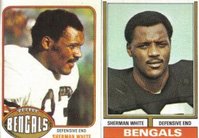 #23 - SHERMAN WHITE - DEFENSIVE TACKLE (1969-1971)
#23 - SHERMAN WHITE - DEFENSIVE TACKLE (1969-1971)
I became an earnest Cal football fan in 1978, in the days of Rich Campbell and John Tuggle. Wanting to learn more about Bears history and CFB in general, I bugged my parents to buy me a glossy encyclopedia book that happened to include photos of all the Kodak All-America teams. There was Chuck Muncie, Steve Rivera - I knew their names. And then there was an enormous defensive tackle named Sherman White, who made the 1971 team. Who was Sherman White?
- He was big enough to excel at defensive tackle, but quick enough to start at defensive end for 11 years in the NFL with the Cincinnati Bengals and Buffalo Bills.
- He came to Berkeley after a year at Laney JC in 1969 and immediately cracked the starting lineup as a sophomore.
- He played his best against Stanford, including an interception return for touchdown in the 29-28 near-miss loss in 1969 and a dominating effort in 1970's 22-14 upset of the Rose Bowl-bound Indians.
- He was twice voted first-team all Pac 8, and was a consensus choice as All-America in 1971.
And he's #23 on the 50 Greatest Golden Bears list. That's who Sherman White is.
PREVIEW - NEVADA v CALIFORNIA @ THE PETE NEWELL CHALLENGE
 The Fazekas
The FazekasLast year, Nevada was more of an inside-out team with 6'10" Kevinn Pinkney playing alongside Fazekas down low. Pinkney is gone, and as a result the Wolf Pack is a much smaller team, often playing a lineup where the tallest player outside Fazekas stands 6'7".
While the Pack is 6-0 and ranked #24 in the nation, they've struggled at times to establish the inside game. Against Santa Clara, a team that Cal thoroughly dominated, Nevada was outscored in the paint 47-26. Cal's advantage is that they start two athletic big men to Nevada's one.
Nick Fazekas (above) is a monster who will play at the next level. His stat line thus far is sick (though against middling competition) - .651 from the floor, 24.3 ppg and 13.3 rpg in only 29 minutes. He is likely the best player Cal will face this year, with great court instincts and the ability to draw opposing big men into quick foul trouble. The other scorer is 6'5" Marcellus Kemp who is averaging nearly 20 ppg, usually at the three. He's shooting .515 from 3-point range. Kemp and Fazekas account for more than 40% of Nevada's shots, which tells you they're a well-coached team.
PG Ramon Sessions is a pass-first guy who distributes well and plays solid defense. Kyle Shiloh (6'3", 8.3 ppg) plays the 2 and is one of the Wolfpack's primary threats from 3-point range, though he's been a bit off this year at .370. He's also regarded as the Pack's best defender. The fifth starter is undersized PF Denis Ikovlev, a juco transfer. Against Cal, expect to see Ikovlev come off the bench in favor of junior center David Ellis (7'1"), who is limited offensively. Off the bench, Lyndale Robinson is a serviceable backup point who comes from a Pac-10 family (father Al was a standout DB at UW). Freshman power forward Lavale McGee is long (6'11") but untested.
From Cal's perspective, everything seems to be clicking since the uninspired win over Marshall. The defense is back, and DeVon Hardin has had two consecutive strong outings. The Bears are still very thin up front, and they would become a less imposing challenge for the Pack if either Anderson or Hardin are forced to the bench for long spells.
Prediction: Nevada is a seasoned, disciplined team that will be much more of a challenge than K-State. Fans hoping for a fast-paced game might be disapointed, because Cal's best bet is to hammer the ball inside and force Fazekas to defend and pick up fouls. Fazekas will get his twenty-something, but the Bears can win if they limit Kemp from the perimeter. Before the season we had this chalked up as a loss, but right now we're willing to ride the wave for one more game.
California 75 Nevada 72
GIVE 'EM THE AXE, RIGHT IN THE NECK
PREVIEW - STANFORD v CALIFORNIA
 When Stanford has the ball
When Stanford has the ball....they'll need to throw it. Cal's run D has been fairly stout over the season, and Stanford has struggled to generate any sort of consistent rushing attack. Stranger things have happened, but we would be very surprised if Stanford runs for 100 yards tomorrow.
So that leaves the game in T.C. Ostrander's hands. T.C. is a better quarterback than the guy who was fed to the wolves in Stanford Stadium last year, but he's still understandably gun-shy under even modest amounts of pressure. However, he's perfectly capable of having a good game if he gets adequate protection. Big Game history is filled with unlikely passing stars.
Cal's four-man pass rush has been anemic this year, so expect the Bears to blitz liberally after the first series or two. The Bears need to force rush throws and turnovers, which have been few and far between in recent weeks. On Stanford's side, we expect lots of ball-control passing, so Cal's back seven will need to continue to tackle pretty well and prevent yards after contact.
The receiver matchups don't favor Stanford unless Evan Moore can go at close to full speed. His size (6'7") would present problems for both of our corners, but he's been a non-factor due to a nagging foot injury.
When Cal has the ball...they will face a Stanford defense that has improved in recent weeks, albeit against some of the worst offenses in the conference (UW and UA). Still, the undersized Stanford D has struggled mightily to stop the power run game, and they have tackled poorly, resulting in lots of big plays and YAC for opponents. Even Arizona ran effectively against Stanford.
However, Cal is in a bonafide offensive slump, particularly in the run game, which hasn't broken 150 yards rushing since the Washington game. Opposing teams have switched to press cover techniques to jam the short passing game, and Bear receivers have failed to make them pay by getting open for deep balls. Our receivers must play a more physical game and make Stanford's corners pay for what should be another afternoon of jams at the line.
Tedford will establish the power run game and dare Stanford to stop Lynch and Forsett. If Stanford plays a more conservative pass D, Longshore should have a field day with change-of-pace short and intermediate routes. If not, it will be up to the receivers to elevate their play and create mismatches.
We don't expect that Stanford will be able to generate much of a pass rush from three rushers + Udofia. Cal's O-line is averaging fewer than one sack allowed per game, which is tops in the Pac 10.
Special Teams...The most compelling reason to watch the 109th Big Game is to watch Wopamo Osaisai try to cover DeSean Jackson on punt returns. The best versus the best. Nothing else too interesting here, other than Stanford's shaky FG game which could hurt them in a low-scoring game.
Intangibles...Normally we'd say this tilts in favor of the underdog; this is Big Game after all. But this Stanford team hasn't played with intensity all year, and there are open divisions between players and coaches. Cal, on the other hand, should be motivated to shake off two disappointing losses and end the season on a positive note.
California 40 Stanford 10
ON A CAROUSEL
Tom Dienhart, a pretty knowledgable college football writer, has an interesting
grab-bag column up on the coaching searches at Alabama, Miami, ASU, etc.
Our favorite part? Dienhart names
thirty-four coaches who he believes could be in the mix for these and other open jobs, and not one of them is named Jeff Tedford. Our second-favorite?
Slick Rick is apparently being talked up for the ASU job. Stoops v Neuheisel in the 40-yard dash to NCAA probation? Priceless.
PALO ALTO - NOVEMBER 20, 2021
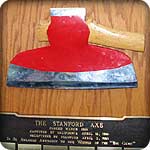
Welcome to the Google/Arrillaga Family Sports Center. I am Biff, your virtual hologuide to the Center. I am fully interactive, so please feel free to address any queries about the rich history of Stanford athletics to me and I will strive to answer them. Perhaps you'd like to begin your tour with a walk through the Hall of Women's Archery, to your left?
Son: Wow, Dad. Stanford has the coolest stuff!
Dad: Yes, Johnny - it does. Let's save archery for later and look at these exhibits right here.
Son: Dad, why is this case empty? And what's with all the spiderwebs?
Dad: Um, well...I don't know, son.
Biff: Allow me to answer your question. This case formerly housed the Stanford Axe.
Son: The Stanford what?
Biff: Axe, my dear boy. The Stanford Axe was passed back and forth between the student bodies of Stanford University and the University of California as a trophy for the winning school in what was once known as the Big Game.
Son: The Big Game? You mean the basketball game against UC Davis?
Biff: No, the Big Game refers to the annual football contest between Cal and Stanford, which traditionally ended the regular season for both schools. The series was discontinued in 2016 after Stanford's re-classificiation as D-1AA in collegiate football. The Cardinal's season now ends with the traditional tilt vs. Occidental.
Son: So the Axe used to be in this case?
Biff: Oh yes! For much of the 20th century, Stanford dominated its rival from across the Bay. During one period under coach Ty Willingham...
Son: Ty Willingham.....Dad, isn't he the coach of Jimmy's high school team?
Biff: Yes - before becoming head coach at Palo Alto High in 2018, coach Willingham led a number of collegiate football programs. Under coach Willingham, Stanford kept the Axe for seven consecutive years. And it sat in this display case for Stanford students and fans to gaze upon it each day.
Son: So what happened?
Biff: Ah, yes. California tired of losing to their rivals, and hired Jeff Tedford as its head coach in 2002.
Son: Governor Tedford?
Biff: Yes, of course, you know Jeff Tedford as the current Governor of California, though he maintains close ties with his adopted alma mater. Under Governor Tedford, the Bears won the final 14 Big Games as well as three national championships. His success led to a general disinterest in college football throughout the South Bay Area.
Son: But Dad! Stanford is so good in so many sports, why did they have to quit football?
Dad: Football is a nasty, brutish sport, Johnny. The Stanford world view was far better aligned with other sports, particularly smaller ones where Stanford's money gave it natural advantages over its competitors.
Son: Like swimming and diving? Or sailing?
Dad: Yes son, like sailing.
Biff: Well said, Dad. Let's move on to the Hall of Club Sports Champions, shall we?
KEY MATCHUPS - STANFORD v CALIFORNIA
Cal's O-Line + Storer v Michael Okwo & Pat Maynor - For the Cardinal to have any sort of success Saturday, they must stop Cal's run game. Stanford runs the 3-4, which puts lots of pressure on their inside backers to take on opposing guards and stop the power run game. Normally I'd say this is a mismatch given the size of Cal up front, but the Bears have really struggled to establish the run game in recent weeks.
DeSean Jackson v Wopamo Osaisai - Stanford's best defenders are at safety (Harrison and Hooper), and they will need to provide regular help to both corners. Still, Osaisai is Stanford's fastest player and a good measuring stick for DeSean. Osaisai is also a demon on punt cover (all-Pac 10), and will be the first Cardinal in Jackson's face on returns.
Pressure v T.C. Ostrander - T.C. and injured colleague Trent Edwards have hit the turf 46 times this season, far and away the most in the conference (ASU is 9th with 33 sacks allowed). Cal has struggled to generate a pass rush, with only 20 sacks in 11 games. This might be the game that Nu'u Tafisi has been waiting for all year.
Jeff Tedford v Walt Harris - Two of the most inventive offensive coaches in America face off on Saturday after two weeks of preparation. Despite their reputations, each has been criticized for conservatism this year - in Tedford's case, it's running in 2nd and short yardage situations; Harris is attacked for not throwing enough on first down. Given Cal's talent advantage on both lines, JT would be wise to ignore his critics and force Stanford to stop the run. Harris, on the other hand, does need to open up the game plan radically and put the team on Ostrander's back.
Stanford Alumni v Apathy - The Band has been neutered, the Tree is in a 12-step program, and no one seems to care about Stanford football anymore. The going line on the chat boards is that Berkeley's not worth the trip - too hostile an environment. Could we see the lowest Stanford turnout in Big Game history?
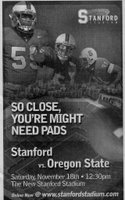
They don't even care enough to run spell-check
CALIFORNIA 78 KANSAS STATE 48
OK, we're officially excited about Cal's basketball team. In the words of Bush 43, that was a thumpin'.
Cal ran pretty successfully, and played very efficiently on offense. The big men were quite good, especially Hardin (12 points, 12 boards). We were shocked, frankly. K-State is an inefficient bunch of good athletes, but Cal looked to be not only better prepared but
more athletic than the Wildcats. Didn't expect that.
On to Nevada and Nick Fazekas on Sunday. GO BEARS!
50 GREATEST GOLDEN BEARS - #24 - MATT HAZELTINE
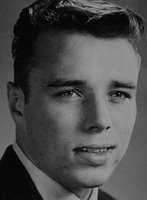 #24 - MATT HAZELTINE - CENTER/LINEBACKER (1951-1954)
#24 - MATT HAZELTINE - CENTER/LINEBACKER (1951-1954)The legend has it that Matt Hazeltine first gained notice when he subbed for the starting center who had broken his shoulder pads during a practice drill in November 1951. If true, that was an expensive equipment malfunction, because Hazeltine never gave the job back. He started the final game of that season, a 20-7 upset of 9-1 Stanford, and ever other game of his storied Cal career.
Hazeltine used his speed and quickness to shut down opposing linebackers and chase down ball carriers. He was twice voted all-conference, and also received All-America honors from the International News Service after both his junior and senior seasons. He led defenses that surrendered an average of 15 points per game from 1952-1954.
The linebacker's relative lack of size affected his draft stock, and San Francisco took him in the 4th round in 1955. It was a wise investment, as Hazeltine became an All-Pro over a fourteen-year career with the 49ers and New York Giants.
Matt Hazeltine's story ended tragically - he contracted anyotrophic lateral sclerosis (ALS) in his forties, and died on January 13, 1987 at the age of 53. Following his untimely death, he was promptly inducted into both the College Football Hall of Fame and the Cal Athletic Hall of Fame.
BIG GAME WEEK - MEET THE 2006 STANFORD CARDINAL

QB - On the bright side,
T.C. Ostrander is the best T.C. since
Magnum PI. On the down side, he is the worst QB in the Pac 10. Ostrander can't be entirely blamed for the poor results, since opposing defenses needn't worry about the Cardinal run game. Still, it's fair to say that Ostrander must have the best game of his career for the Cardinal to have a shot at the upset.
OL - A bad unit - probably the worst in the Pac 10. Stanford surrenders more than four sacks per game, and the Cardinal average a truly pitiful 2.1 yards per rushing attempt. I don't know what else to say - they're simply awful. What's worse, four of the five starters are upperclassmen.
Receivers - This unit has been devastated by injury.
Evan Moore was supposed to have a big year, but has instead spent time in the training room and Harris' doghouse and has only 11 catches on the season. Stanford lost two of its top 3 receivers for the season when Mark Bradford and Marcus McCutcheon went down with knee injuries. In their place, Stanford's leading receiver with 28 catches is freshman
Richard Sherman, who possesses good size (6'3") and speed. Walk-on junior
Kelton Lynn is a possession receiver who can find spots in the zone; freshman
Austin Yancy will also see the field.
Jim Dray is a serviceable sophomore tight end who is looked to as more of a primary receiver in light of Stanford's injuries.
RB - Stanford generally runs a two-back set with
Anthony Kimble at tailback and
Emeka Nnoli at FB. Kimble was switched by Harris from receiver to running back before the 2005 season, and he has yet to find his groove at the new position. Still, he's fairly talented and could be a much bigger threat behind a competent offensive line. Nnoli is Byron Storer without the blocking game; starter Nick Frank had to retire early in the season due to a spine injury. Freshman
Toby Gerhart will rotate in at tailback and is an intriguing talent. Stanford will involve their backs in the passing game. Kimble can also throw, having completed a 57-yard touchdown against Notre Dame.
DL - Stanford runs the 3-4 for no good reason. Their nose tackle,
Ekom Udofia, was highly regarded coming out of high school, and will eventually be a good performer, but he is miscast on the nose. He would be far more effective at the tackle, where he could use his quickness to greater effect. Stanford's ends are pretty average and have been unable to generate a pass rush -
Chris Horn and
Pannel Egboh each have 1.5 sacks, though Egboh is the better run defender.
LB - The strength of a pretty weak team; the Cardinal's best overall player is
Michael Okwo, a small but
very quick inside backer. He will represent a challenge for Storer and our guards in the run game.
Pat Maynor, he of the
recurring staph infection, starts at the other inside backer - also smallish, he's like Okwo without the athleticism.
Udeme Udofia is your classic stand-up defensive end who pressures the quarterback and does little else.
Clint Snyder, the other outside backer, is a good young player. Highly regarded sophomore
Will Powers will also see time on Saturday.
DB - A decent unit, led by SS
Brandon Harrison, who has been banged up this year but will start on Saturday.
Trevor Hooper starts at free and makes lots of tackles - too many tackles. Corners are
Wopamo Osaisai who possess great speed if not great cover instincts and senior
Nick Sanchez, who will be assigned to Jordan/Hawkins. Harris will run lots of folks through a secondary that has allowed opposing QBs to complete 61% of their passes.
ST - Terrible on both kick and punt returns (10th and 9th in the conference, respectively), but pretty good on punt cover. Kicker
Aaron Zagory is only 7-12 on the year.
Overall - Stanford is dead last in the conference in both scoring offense and scoring defense for good reason. Injuries have robbed the Cardinal of four of their top skill performers, but it's still unclear what a healthy Edwards, Frank, Bradford and McCutcheon would mean to a team that is completely overmatched in the trenches.
SCOUTING REPORT: KANSAS STATE v CALIFORNIA
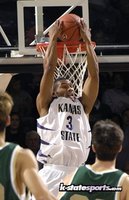
Tonight the 5-1 California Golden Bears host Kansas State (4-1) and their notorious new coach Bob Huggins at Haas Pavillion. The game is being televised nationally (!) by Fox Sports.
Thus far K-State has been a streaky team, evidenced by a 24-point blowout loss at New Mexico last week. They haven't shot well at all, though they play with the defensive intensity that was characteristic of Huggins' teams at Cincinnati. This is a very winnable game for the Golden Bears, provided they play their typical solid defense and refuse to settle for quick jumpers.
Backcourt -
Blake Young starts at the point and
Lance Harris is at the two guard. Young is a Huggy juco import and a classic shoot-first point with good quickness on the offensive end. If he gets hot, K-State becomes a different team and could give the Bears problems. Harris hit for 26 against Coppin State, but is occasionally streaky from behind the arc. One of K-State's problems is that Young consumes too many possessions and fails to set up Harris in good situations. Still, Harris is athletic enough to create on his own.
Frontcourt -
Cartier Martin starts at the four and is the Wildcats' best offensive player.
David Hoskins is a 6'5" three with athleticism but an erratic offensive game. Huggins will likely start
Jason Bennett in the middle to deal with Hardin. Bennett is enormous (7'3") but very limited offensively.
Akeem Wright will also see time at the three and is an efficient rebounder.
Keys to the Game:
* Limit second shots. K-State is an athletic team that goes hard to the glass. Cal must limit them to one shot on offensive possessions. The Wildcats haven't shown that they can generate good shots out of a half-court offense (a .355 shooting percentage on the year).
* Keep them in the half-court. Young hasn't shown the ability to distribute the ball efficiently and the Wildcats wind up shooting lots of low-percentage threes. An up-tempo game is more suited to K-State's offensive gifts.
Prediction: We're worried about K-State's ability to generate second shots - the Wildcats are averaging nearly 20 offensive rebounds per game (albeit against smaller teams than Cal). So, this pick is based on our belief that DeVon Hardin is truly back, and that Cal's front line can stay out of foul trouble. If either Anderson or Hardin spend significant time on the bench, the Bears could be in trouble.
California 75 Kansas State 67
THE WRONG MAN, AGAIN
Ted Leland helped build a truly successful athletic program at Stanford. 11 Directors' Cups in 14 years in Palo Alto. 50 National Championships and 173 conference titles, more than any school in America during his tenure.
But Ted Leland made two mistakes. Two very big mistakes.

His first, unpardonable sin was hiring his pal Buddy Teevens to be a D-1A Head Coach. This hire was elitist cronyism at its worst, and almost undid all of Leland's good works in one fell swoop. Buddy was the head man at Tulane and Dartmouth, where Leland served as AD. He also carried Steve Spurrier's clipboard for three years. He had the barest of qualifications to be a HC, yet Leland chose him over a group of finalists that included Mike Riley.
Press reports described Teevens as acting "fidgety" at his hiring press conference. He kept on acting fidgety through the next three Cardinal seasons and was canned after compiling a 10-23 record. Hired for his alleged recruiting prowess, Teevens actually lowered the talent level at Stanford. He apparently forgot to recruit offensive linemen, and in the process ruined what should have been a fine collegiate career for the perpetually-injured Trent Edwards.
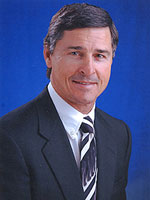
So Leland had another choice to make in the fall of 2004, a chance at redemption. And he hired Walt Harris. Another crony.
The press conference was again telling. Instead of fidgeting, Harris stood solemnly, as if attending a funeral. He curtly refused to answer questions about his former employer, Pitt, who eagerly showed him the door despite a string of bowl appearances.
The warning signs were already there - Harris had an unattractive habit of calling individual Pitt players out in the press for poor performance. His play-calling was too cute by half - his stubborn insistence on the 'swinging gate' formation for PATs led to two misses in a two-point loss to Texas A&M in 2003. In 2004 he had QB Tyler Palko take a knee at the end of the first half to set up a field goal attempt in an eventual loss to Connecticut, rather than taking a shot at the end zone. He generally acted like a man whose job was a chore, and Pitt players and alumni shed few tears when he decamped for Palo Alto.
At Stanford, he has tried to weed out the deadwood by bullying his players in the press. After last year's loss to Cal, he said that his players simply didn't measure up to the Bears. He took Evan Moore and T.C. Ostrander to task for their work habits, and alleged that TE Matt Traverso was faking an injury. These tactics might be OK if they yielded improved performance, but instead Moore and Ostrander have struggled through disappointing seasons and Traverso has yet to see the field. Harris' players have also noted serious communications problems the coaching staff on issues as mundane as personal hygiene. He insists on running a 3-4 defensive scheme without proper personnel along the defensive front. And, of course, Walt treats the local media like uninvited guests at a family reunion.
The guess here is that Walt has another year of credit left with Stanford alums. And he might eventually succeed, because he's got a brilliant offensive mind hiding somewhere behind his anti-social personality. Will he get the chance? There's a new AD on the Farm, and he's got a crony of his own - recently unemployed Iowa State head coach Dan McCarney. A Big Game blowout, and we might see whether the third time's the charm for Stanford's 'friends and family' approach to big-time college football.
CONGRATULATIONS, GOLDEN BEARS
Yesterday Marshawn Lynch was named the Pac-10 Offensive Player of the Year, and Daymeion Hughes was named Pat Tillman Defensive POY.
Never before have Cal players earned the Pac-10's Offensive and Defensive Player of the Year honors in the same season. In fact, only three times since 1983 - the year when the conference began to award offense and defense awards - has a single team won both of the awards.
- In 1990, Husky RB Greg Lewis won the Offensive award, and DT Steve Emtman shared honors with Arizona CB Darryl Lewis.
- In 1991, Emtman repeated as Defensive POY, and Husky WR Mario Bailey shared Offense honors with Cal QB Mike Pawlawski.
- In 2004, USC's Reggie Bush and Matt Leinart shared Offensive honors, and DT Shaun Cody was co-POY with Oregon State DE Bill Swancutt. (SC's Michael Patterson should have won the award in both '03 and '04, BTW)
You'll notice one thing about these teams, of course. They all won the conference championship, and two of the three were national champions.
In addition to Hughes and Lynch, four other Golden Bears were named first-team all-conference. DeSean Jackson won honors at two positions - wide receiver and punt returner, while Desmond Bishop and Brandon Mebane won honors on the first-team defense. Lastly, sophomore center Alex Mack was named to the first-team offense along with USC's Ryan Kalil (the Pac-10 honors the best slate of offensive linemen, regardless of position). DE Nu'u Tafisi, ST Byron Storer, OT Mike Gibson, P Andrew Larson and TE Craig Stevens earned second-team honors.
10 MOST MEMORABLE BIG GAMES
#10 - Bowing Out in StyleCALIFORNIA 24 STANFORD 27 (November 20, 1976)
Jack Christiansen, who was canned as the Indians' head coach the day before the game, was carried
onto the field by his players. His inspired Cardinals were matched against a 5-5 Cal team led by Joe Roth, playing his final game in Berkeley. Cal led 24-19 with 2:20 left and the ball on its own 2 yard line. Bears' RB Markey Crane fumbled a pitch from Roth, Stanford recovered, and scored with 1:31 remaining to win one last game for their soon to be ex-coach. Things only got better for the Furdies, since their next head man was a fella named Walsh.
 #9 - No Roses for You
#9 - No Roses for YouCALIFORNIA 16 STANFORD 0 (November 29, 1941)
With a win, Stanford could clinch a share of the PCC championship. The Indians featured Frankie Albert, the greatest QB in school history to that point, and were defending national champions. Cal was a mediocre 3-5, but the Bears somehow shut down the vaunted Indian attack and led 9-0 in the 4th quarter. John Herrero blocked a Stanford punt deep in Indian territory, and Cal All-American tackle Bob Reinhard grabbed it and spun into the end zone for the game's final points. A stunned Stanford Stadium crowd could barely believe its eyes - mighty Stanford had been shut out, and the Axe was California's once again.
#8 - Twelve Seconds Over BerkeleyCALIFORNIA 25 STANFORD 27 (November 17, 1990)
The only time I've cried at a sporting event. Everything that could go wrong, did. Tuan Van Le was one thing, but this was a series of catastrophes - like a bad wreck on the highway. Stanford scored. Russell White somehow missed the onside kick. John Belli got a ticky-tack roughing penalty on Jason Palumbis on a simple throwaway pass. And then the field goal, and that song. That song. It's frankly too painful to write about, so let's move on.
#7 - Win One for the ZipperCALIFORNIA 17 STANFORD 11 (November 22, 1986)
After a 50-18 blowout loss to UW, Coach Kapp offered to show a reporter his block and tackle. His descent from failed football coach to self-parody complete, Kapp was a dead man walking heading into the Big Game. The Bears were 1-9 and had been outscored 104-12 in their previous three games. Stanford was 7-2 and headed for the Gator Bowl, led by stars John Paye, Dave Wyman and bruising fullback Brad Muster. And of course, the 18.5-point underdog Bears won 17-11 in an ugly defensive struggle that sent Joe out a winner. Following the game Hardy Nickerson, who along with Majette Whiteside had terrorized Paye all afternoon long, climbed the tower and led the Cal band in a joyous celebration on the field.
#6 - The Duel 
CALIFORNIA 21 STANFORD 21 (November 21, 1953)
Bobby Garrett. Paul Larson. The greatest matchup of quarterbacks in Big Game history. Cal's Larson led the NCAA in total offense that year, and Stanford's Garrett would be the #1 overall pick in the 1954 NFL Draft. Ironically, the two would shine on defense, each making a crucial interception of the other to stop scoring drives and preserve the 21-21 tie. The program from that day (
right) is fairly typical of the era - demure but unabashedly sexual imagery used to sell a football game. Pity the poor Rock Hudson look-alike in the back.
Who should he choose?#5 - Mud BowlCALIFORNIA 24 STANFORD 21 (November 18, 1972)
Heavy rains had left Memorial Stadium a quagmire by kickoff, and the ensuing game was appropriate sloppy. The classic see-saw battle involved several lead changes and lots of turnovers. Cal QB Vince Ferragamo was picked off four times, but somehow kept the Bears in the game with clutch passes to WR Steve Sweeney. Stanford QB Mike Boryla drove the Cardinals to a go-ahead touchdown and a 21-18 lead with three minutes left to play. All looked lost for the Bears when Ferragamo threw his final interception of the day on the next possession, but inexplicably Boryla returned the favor, and Cal took possession with 1:13 to play. The Bears' sophomore QB seemed to relax under the mounting pressure, and calmly drove his team through the muck to the Stanford nine yard line with three seconds to play. On the game's last snap, he hit a mud-covered Sweeney in the back of the end zone for the score which secured the upset for the 3-8 Bears.
#4 - Mike Fucking LangfordCALIFORNIA 20 STANFORD 22 (November 23, 1974)
A powerful Cal offense, led by QB Steve Bartkowski and RB Chuck Muncie, figured to steamroll the Cardinals in Berkeley. The Bears had lost only twice - to Florida and UCLA, while Stanford came in 4-4-2, having struggled to beat lowly Oregon State and Washington State for two of those victories. But Cal struggled to run the ball, netting only 28 yards on the ground for the afternoon. Bartkowski's passing kept Cal in the game, but they still trailed 19-10 with seven minutes remaining. Jim Breech's 40 yard field goal cut the margin to six, and then Bartkowski led the Bears on a last-minute drive for the go-ahead score. His last pass of the 75 yard drive hit Steve Rivera in the corner of the end zone with 26 seconds to play, and Cal had seemingly won 20-19. Stanford returned the kickoff to the 25, and then backup QB Guy Benjamin connected on two long passes to bring the Cardinals to the Cal 33 with two seconds to play. In came Langford, and his 50-yarder ended one of the more remarkable Big Games in history.
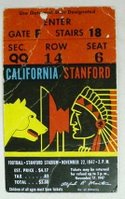 #3 - Put Me in Coach
#3 - Put Me in CoachCALIFORNIA 21 STANFORD 18 (November 22, 1947)
Cal came into Palo Alto at 8-1; Stanford was winless for the first time since 1918. What figured to be an easy Golden Bear victory was anything but, as an inspired Stanford team climbed to an 18-14 lead late in the fourth quarter. Halfback Paul Keckley, who was out with a separated shoulder, begged Coach Pappy Waldorf to insert him on defense. Waldorf agreed, and Keckley made a crucial tackle against the Indians to turn the ball over on downs to Cal. On Cal's first offensive snap, Jackie Jensen threw a swing pass to Keckley, who ran through the entire Stanford defense for an 80-yard game-winning score, the longest in Golden Bear history.
#2 - The End of the Wonder 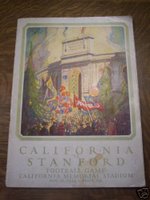
CALIFORNIA 20 STANFORD 20 (November 22, 1924)
Walter Camp, who had ventured west for the game, called it one of the finest games he had ever witnessed. Certainly there was never a matchup of such elite teams in a Big Game. Cal was nearing the end of the Wonder Team years under coach Andy Smith; the Bears had gone 43-0-3 in its previous 46 games. Stanford, under legendary coach Pop Warner, was 7-0, having surrendered only 22 points all season. The Indians were led by Hall of Fame running back Ernie Nevers, but Nevers had broken his ankle in the previous game and was unavailable in Berkeley. Stanford rallied from a two-touchdown deficit in the fourth quarter to tie the game, and secure its spot in the Rose Bowl, where it would at least lose to Notre Dame's Four Horsemen. This game marked the end of an era in Berkeley - Cal's 1925 squad would lose three games and its coach when Andy Smith died suddenly of pneumonia the following January.
#1 - "The Ball is Still Loose"CALIFORNIA 25 STANFORD 20 (November 20, 1982)
What else can be said about this game? Only that it would still be #1 if The Play had never happened. John Elway's final drive was greater than anything he did as a professional. His 4th and long bullet to Emile Harry through the Cal zone was a thing of beauty, even to blue and gold eyes. Diving touchdown catches by Mariet Ford and Wes Howell kept Cal in the game up to the end. And oh, what an ending. The Play alone doesn't make 1982 the most memorable of all Big Games. No, the inspired playground lunacy of Messrs. Moen, Rodgers, Garner and Ford makes the 1982 Cal/Stanford game the greatest in the history of the sport.
SCHADENFREUDE
It's important to be careful when
writing things on the Internet. Some of these things can read very, very differently five years later.
There's two ways to look at that linked article. On the one hand, it serves as a cautionary tale for anyone who would pronounce Stanford a dead program just because they're playing a backup quarterback, have no running game and are coached by a manic-depressive who can't recruit. On the other hand, it's an awful lot of fun to see how the worm has turned for the author of that piece and her fabulous colleagues in red and white.
Door #2, please. I loves me some
schadenfreude.
BEAT STANFORD!
SEASON ON THE BRINK - OREGON BASKETBALL
The most interesting basketball team in the country hails from Eugene, Oregon - a team full of immense talents and outrageous head cases, led by an alum who has turned everyone in the community against him through arrogant behavior and a wandering jimmystick. Coming to a Big Top near you, the three ring circus that is the Oregon Ducks!
 Good news
Good news: Well, for starters they have more offensive talent than anyone this side of Westwood and Tucson.
Aaron Brooks is maddeningly inconsistent, but when he's on he's as good a pure point guard as any in the conference.
Chamberlain Oguchi has the best name in the conference and is money from beyond the arc; he can be a good defender when he puts in the effort.
Malik Hairston (
left) hasn't played yet this year due to a groin injury, but he's the team's top returning scorer (15.0 ppg) and one of the few Ducks who seemed to play hard all of last year.
Maarty Leunen is a rebounding fool at PF who was bothered by a gimpy ankle for much of 2005-6.
According to RPI guru Ken Pomeroy, Oregon was the
2nd unluckiest team in the country last year. We'll get into Pomeroy's ratings in a subsequent piece, but he's picking the Ducks as his dark horse team to go deep in the postseason.
Bad news: Ernie Kent recruits big men like Ben Braun recruits point guards - only occasionally, and with mixed results.
Mitch Platt returns from a medical redshirt year at the five spot, but behind him and Leunen there ain't much. So far Platt has come off the bench and Kent has started 6'5" swingman
Bryce Taylor at the 4, with Leunen at the 5.
Adam Zahn started last year, but hasn't seen the court much in '06. That's a really small team, and all the perimeter scoring in the world won't help them beat the bigger teams in the Pac. The Ducks have one true center in junior
Ray Schafer, and he's not much of a threat.
Jordan Kent (son of the HC) will add athleticism at SG once the Ducks are done playing in their miserable bowl game.
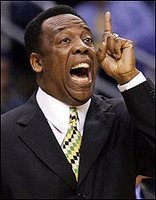
Then there's the other stuff. Oregon was so dysfunctional last year that the players held a players-only meeting, and didn't invite Jordan Kent. The Ducks openly loathe their head coach (and, apparently, his kid) and usually play with the cohesion and togetherness of their professional counterparts in Portland. Kent has helped dig his own grave with, er, questionable personal behavior including a lost weekend "recruiting" in Mexico and several allegations of infidelity. Unless he both wins and improves the atmosphere around himself and the program, this is his last year in Eugene.
New faces:
Tajuan Porter is Oregon's answer to Jerome Randle - a 5'6" freshman who's very quick and will back up Brooks at the point. Juco transfer
Josh Akwenuke will provide minutes at the three. Big body
Joevan Catron may be called on to help inside given how thin Oregon is up front.
Prediction: Fourth place. We're in the camp who thinks Oregon might pull it together this year and surprise some people. They are very athletic, with the best perimeter game in the conference. Bigger teams will give them trouble, but the Ducks are likely to outscore most opponents. It would not surprise us, though, if the wheels completely came off this team, and they finished seventh and out of the postseason money. The Ducks' first big test comes Wednesday at Georgetown.
KOETTER IS GONE
Even a 28-14 asskicking of UofA in Tucson couldn't
save his hide. Apparently some big donors pushed a button a couple of weeks ago, and that was that.
We will miss you, Dirk. Every time a coach looks weak in public, or a team collapses emotionally at the first sign of adversity, or a left tackle jumps offsides two plays in a row, we will think of you.

God speed, Dirk Koetter
STANFORD WEEK
Many of the great rivalries are fundamentally class rivalries - the "big-city" university v the land grant agriculture college. This is what fuels Alabama/Auburn, or Oregon/OSU. Some are even about religion (BYU/Utah) or fashion (USC/UCLA).
Cal/Stanford is the only great rivalry that's fundamentally about ideology. And by ideology, we don't mean the traditional left-right distinction - Stanford's a good bit more conservative than Cal, but they're both squarely in God-hating commie territory.
No, the ideology at play here is authoritarianism. Cal teaches its own to question authority by imposing a faceless, soul-crushing bureaucracy upon its students. No classes? Tough shit. No housing? There's always co-ops. Want the personal touch? Try getting to know your 1200 classmates in Anthro 1. Four years at Berkeley feels like a Kafka novel - you come out with a perhaps too-healthy skepticism of professors, administrators, Presidents and the like.
Stanford is a school next to a mall and some golf courses that is populated by cheerful authority figures who want to like you. They serve as your counselor, and help you choose your classes. They arrange comfy dorm rooms, and social events with your fellow fascinating students drawn from all parts of the country. They want you to succeed, because you're one of them - the few, the proud, the elites. Isn't it grand?
 Serenity Now
Serenity Now
You exit Stanford feeling really, really good about yourself. You exit Berkeley happy to have survived the experience. Berkeley is exhilirating; Stanford is pleasant. Both sets of alumni run the world, but only one group of alumni feels
entitled to.
Leland Stanford didn't attend the university that bears his name. He simply founded it - with money stolen from the pockets of the good men and women of California, on the backs of Chinese immigrants that his railroad literally worked to death. Want to know why our State Capitol is in Sacramento? Because Leland Stanford's railroad was going to end there, and because he said so. The California built by Stanford and his fellow Robber Barons was, in essence, a kleptocracy benefiting the elites at the expense of the masses. After all - they
deserved it.
The University of California, by contrast, was established by Governor Frederick Low in 1868 with the passage of the Organic Act. UC was designed on the University of Michigan model and sought to make higher education available to all residents of the state, regardless of their ability to pay.
Prominent Stanford alumni in the corporate world include Steve Ballmer, Phil Knight - uber-elites. Cal has Steve Wozniak, who did all the hard work at Apple and then retired to do philanthropy instead of press conferences, and the Haas family, noted for their pursuit of business ethics.
Cal has Alice Waters, Timothy Leary, Joan Didion - slightly kooky trailblazers in their respective fields. Stanford has Herbert Hoover, who couldn't be bothered with all that talk of a Great Depression, and Gray Davis, who never left his office to notice the State collapsing around him. Elites. Cal's Laura Tyson is famous for presiding over the great Clinton economic run of the 1990s as head of the CEA and NEC. Stanford's Condi Rice is famous for presiding over the collapse of the world.
Some may look on this as a false distinction between two privileged groups, but we disagree. The ideology that separates Cal and Stanford, Berkeley and Palo Alto, rugged individualism and elitist group-think is what brings the taste of bile to our lips every time we see that dancing tree.
It's not jealousy, it's resentment - and there's a difference. You see, we know those smug, snarky clowns in red and white are someday going to fuck up the entire world, and we're not happy about it.
CAL TAKES THE GREAT ALASKA SHOOTOUT

5-1 and a Great Alaska Shootout title qualifies as a nice little start for the Golden Bears. Kudos to our favorite scapegoat Omar Wilkes for playing well with 18 points, and also to Mr. Hardin for bringing his lunchpail on both ends. We still can't figure this team out - but we'll know more Wednesday night versus Kansas State.


 California 26, Stanford 17....Uninspired play by our Golden Bears, but just enough to keep the Axe in Berkeley. A full report card to follow, and then we focus on the Texas A&M Aggies and our pleasantly surprising basketball team. GO BEARS!
California 26, Stanford 17....Uninspired play by our Golden Bears, but just enough to keep the Axe in Berkeley. A full report card to follow, and then we focus on the Texas A&M Aggies and our pleasantly surprising basketball team. GO BEARS!
 #23 - SHERMAN WHITE - DEFENSIVE TACKLE (1969-1971)
#23 - SHERMAN WHITE - DEFENSIVE TACKLE (1969-1971) When Stanford has the ball....they'll need to throw it. Cal's run D has been fairly stout over the season, and Stanford has struggled to generate any sort of consistent rushing attack. Stranger things have happened, but we would be very surprised if Stanford runs for 100 yards tomorrow.
When Stanford has the ball....they'll need to throw it. Cal's run D has been fairly stout over the season, and Stanford has struggled to generate any sort of consistent rushing attack. Stranger things have happened, but we would be very surprised if Stanford runs for 100 yards tomorrow.

 #24 - MATT HAZELTINE - CENTER/LINEBACKER (1951-1954)
#24 - MATT HAZELTINE - CENTER/LINEBACKER (1951-1954)
 Tonight the 5-1 California Golden Bears host Kansas State (4-1) and their notorious new coach Bob Huggins at Haas Pavillion. The game is being televised nationally (!) by Fox Sports.
Tonight the 5-1 California Golden Bears host Kansas State (4-1) and their notorious new coach Bob Huggins at Haas Pavillion. The game is being televised nationally (!) by Fox Sports. His first, unpardonable sin was hiring his pal Buddy Teevens to be a D-1A Head Coach. This hire was elitist cronyism at its worst, and almost undid all of Leland's good works in one fell swoop. Buddy was the head man at Tulane and Dartmouth, where Leland served as AD. He also carried Steve Spurrier's clipboard for three years. He had the barest of qualifications to be a HC, yet Leland chose him over a group of finalists that included Mike Riley.
His first, unpardonable sin was hiring his pal Buddy Teevens to be a D-1A Head Coach. This hire was elitist cronyism at its worst, and almost undid all of Leland's good works in one fell swoop. Buddy was the head man at Tulane and Dartmouth, where Leland served as AD. He also carried Steve Spurrier's clipboard for three years. He had the barest of qualifications to be a HC, yet Leland chose him over a group of finalists that included Mike Riley.
 #9 - No Roses for You
#9 - No Roses for You
 #3 - Put Me in Coach
#3 - Put Me in Coach
 Good news: Well, for starters they have more offensive talent than anyone this side of Westwood and Tucson. Aaron Brooks is maddeningly inconsistent, but when he's on he's as good a pure point guard as any in the conference. Chamberlain Oguchi has the best name in the conference and is money from beyond the arc; he can be a good defender when he puts in the effort. Malik Hairston (left) hasn't played yet this year due to a groin injury, but he's the team's top returning scorer (15.0 ppg) and one of the few Ducks who seemed to play hard all of last year. Maarty Leunen is a rebounding fool at PF who was bothered by a gimpy ankle for much of 2005-6.
Good news: Well, for starters they have more offensive talent than anyone this side of Westwood and Tucson. Aaron Brooks is maddeningly inconsistent, but when he's on he's as good a pure point guard as any in the conference. Chamberlain Oguchi has the best name in the conference and is money from beyond the arc; he can be a good defender when he puts in the effort. Malik Hairston (left) hasn't played yet this year due to a groin injury, but he's the team's top returning scorer (15.0 ppg) and one of the few Ducks who seemed to play hard all of last year. Maarty Leunen is a rebounding fool at PF who was bothered by a gimpy ankle for much of 2005-6.

 Serenity Now
Serenity Now 5-1 and a Great Alaska Shootout title qualifies as a nice little start for the Golden Bears. Kudos to our favorite scapegoat Omar Wilkes for playing well with 18 points, and also to Mr. Hardin for bringing his lunchpail on both ends. We still can't figure this team out - but we'll know more Wednesday night versus Kansas State.
5-1 and a Great Alaska Shootout title qualifies as a nice little start for the Golden Bears. Kudos to our favorite scapegoat Omar Wilkes for playing well with 18 points, and also to Mr. Hardin for bringing his lunchpail on both ends. We still can't figure this team out - but we'll know more Wednesday night versus Kansas State.